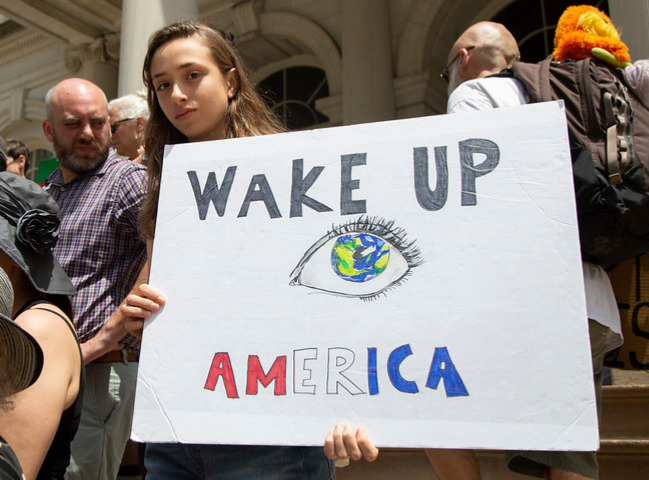As temperatures and sea levels rise, the world turns to young people to solve the greatest challenge in human history—a burden felt by youth activists from New York City to New Delhi, said panelists and audience members at the Waterfront Alliance Annual Conference in Lower Manhattan Tuesday.

John McCarten/NYC Council
A climate change rally on the steps of City Hall in 2019.For about two centuries, people and corporations have been pumping greenhouse gasses into the atmosphere, permanently altering the global climate with catastrophic consequences.
As temperatures and sea levels rise, the world turns to young people to solve the greatest challenge in human history—a burden felt by youth activists from New York City to New Delhi, said panelists and audience members at the Waterfront Alliance’s annual Waterfront Conference in Lower Manhattan Tuesday.
Young people are also the ones fostering environmental justice to correct generations of disparities in communities of color, said Saad Amer, a consultant to the United Nations and co-founder of the voter mobilization group Plus1Vote.
“Now that we’re finally waking up to the realities of the climate crisis, there is a way we can address the climate crisis and fix those issues,” Amer said. “And there’s a way we can address the climate crisis and make those problems worse.”
City Limits’ environmental reporter Liz Donovan moderated the panel, which featured Amer, advocacy coordinator Lonnie Portis of WE ACT for Environmental Justice, and local historian Dr. Sarah Seidman, who discussed the “great expectations” hoisted on the shoulders of the youth movement. The conversation—titled “The Pressures on the Youth Climate Movement: Do We Expect Youth to Do It All?”—was one of more than a dozen sessions at the conference, where City Limits served as media sponsor.
“A lot of youth climate activists have incredibly high expectations placed upon them,” Amer said.
Young climate organizers—a loosely-defined but powerful cohort—are indeed driving efforts to reduce or reverse climate change, in part by highlighting the established science, rather than continuing to debate it, he added. “The youth in particular are not confused about the science. At this point it’s about implementation.”
Emissions have spiked again following a pandemic-induced decline, thanks to fewer planes in the air and vehicles on the road during the early days of the COVID crisis. Nations around the world are nowhere near the Paris Agreement goals of nearly halving global emissions by 2030 compared to 2010 levels and reaching net-zero by 2050, Amer said.
Portis, whose past work includes advocating to transform Rikers Island into a renewable energy hub, said time is running out for lawmakers to enact far-reaching legislation. But too often, they lack the political courage, he added.
“Everything becomes short-term or shortsighted when it comes to funding things,” Portis said. “There are so many opportunities to fund the future and make these investments now.”
Panelists and audience members highlighted the crucial role of young people of color who lead the global mobilization for sustainability, but whose contributions are diminished in mainstream narratives. Portis discussed the overlapping movements to end racist and environmental injustice.
“We should always be looking at, where is the environmental injustice, and how do we correct that,” Portis said. “It’s really important we don’t separate these movements and realize they are the one in the same, and I think that a lot of Black and Latinx youth are really leading that.”
Seidman, a historian specializing in social movements at the Museum of the City of New York, linked current youth activism to the direct actions of earlier generations. “There’s a range of tactics folks use, and most were created by someone else in earlier movements,” Seidman said, citing actions by the Young Lords in Northern Manhattan and The Bronx.
“The Young Lords were creative,” she said. “They commandeered x-ray trucks, set garbage not being picked up in their neighborhood on fire.”
“Acknowledging those histories is pretty powerful,” she added.
READ MORE: Former Young Lords Reflect on Protests, Racism and Police Violence
Each panelist also encouraged attendees to act locally to confront the climate crisis, and to keep from feeling despondent when considering its devastating impact.
“Everything going on climate-wise can be really overwhelming and when youth talk about the climate crisis they talk on a global level that makes it seem impossible,” Portis said. “Bring it down to a more local level—your neighborhood, your school, the block you live [on].”
Local activism, like turning a block around a school into a “green zone” full of trees and free from cars, can make the movement feel “more grounded, personal, attainable,” he added.
Amer, for his part, said he is not always optimistic about the future, but finds energy in the work of change.
“What keeps me motivated is taking action, when I feel like I’m doing something and see the movement building,” Amer said. “Registering voters and motivating people to come out to vote to put in place elected officials who will champion the causes we have to change.”









